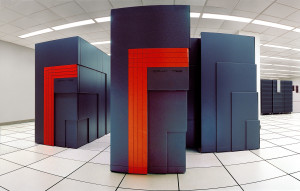DESI Shares Largest 3D Map of the Universe Yet
Dark Energy Spectroscopic Instrument releases data on 18.7 million galaxies, quasars, and stars — the largest dataset of its kind ever shared. » Read More
More Efficient Fusion
So-called “slow waves” waste energy in fusion reactions. Recent simulations successfully tested a new method to stop their formation. » Read More
NERSC Launches IBM Quantum Innovation Center
NERSC users can now apply to access quantum computing resources through a partnership with IBM. » Read More
AI Shows Promise for Mapping Disease Progression
Quantum Computing Partnership Extended
After a successful first year punctuated by strong scientific results, NERSC’s partnership with QuEra Computing has been extended. » Read More
National Energy Research Scientific Computing Center
Computing at NERSC
Now Computing
Some of the science now being computed at NERSC
Numbers not changing? Check the center status page for information.
Did You Know?
When did NERSC start naming flagship systems in honor of scientists?
Since NERSC moved to Berkeley Lab in 1996, the Department of Energy’s primary scientific computing facility has named all of its supercomputers after scientists.
The naming tradition started in the late 1990s with NERSC’s flagship Cray T3E system. It was called “MCurie” in honor of Marie Curie, the French-Polish physicist and chemist known for her pioneering research on radioactivity. In November 1997, MCurie was the fifth most powerful supercomputer in the world. The system had 512 processors and a theoretical peak speed of 461 billion calculations per second (461 Gigaflop/s). At the time, it was the nation’s most powerful supercomputer for unclassified research.
Science News

DESI Opens Access to the Largest 3D Map of the Universe Yet March 19, 2025

Simulation Confirms Method for More Efficient Fusion January 29, 2025

Durable New Catalyst Solves Persistent Chemistry Problem January 7, 2025

AI Shows Promise for Mapping Disease Progression November 1, 2024

Perlmutter Helps Identify 'Exquisite' Gravitational Lens October 10, 2024

Magnifying Deep Space Through the 'Carousel Lens' September 18, 2024

Collaboration Exploring Neutral Atom Technology Expanded for Second Year September 4, 2024
Center News

Five Users Win NERSC Early Career Achievement Awards January 31, 2025

NERSC Launches IBM Quantum Innovation Center January 21, 2025

NERSC Staff Awarded for ECP Leadership January 15, 2025

NERSC Supports 2024 Gordon Bell Prize Winner January 7, 2025

Tina Declerck to Retire After Decades on the Cutting Edge December 12, 2024

New Report Quantifies Value and Impact of Research at NERSC December 6, 2024

NERSC Staff Gear Up for SC24 November 13, 2024








